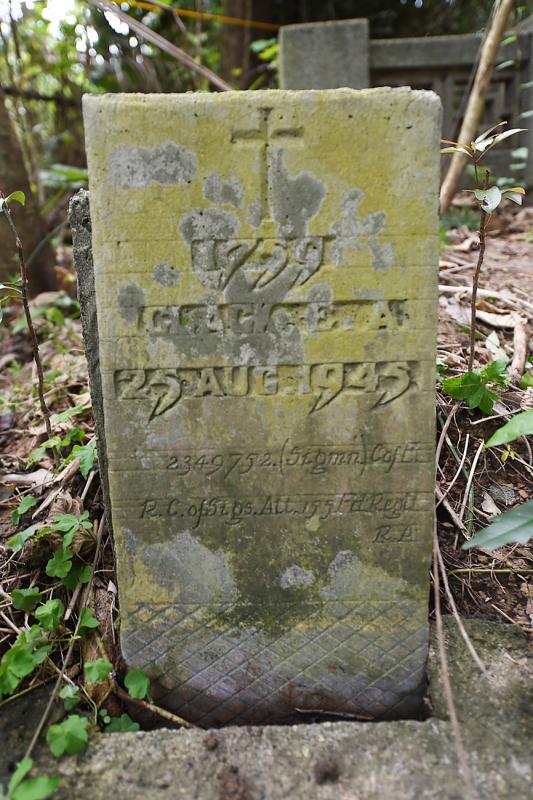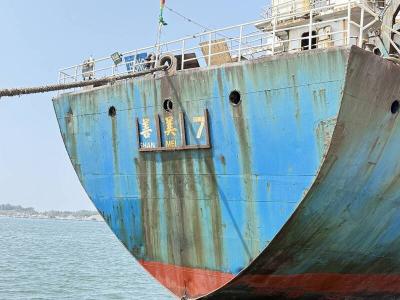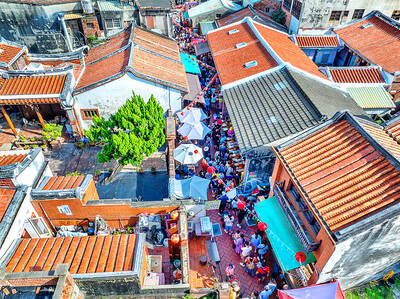A nearly 80-year-old headstone with an inscription in English discovered in Taipei, which experts said could indicate the final resting place of a prisoner of war (POW) imprisoned by Japan in Taiwan during World War II, has been stolen before it could be properly analyzed.
The Taipei City Government on Jan. 28 ordered the relocation of 30 graves by April 30 as part of a road expansion plan in the hills near Lane 137, Fude Street in Xinyi District (信義).
Visitors to the area then discovered a headstone with English lettering, pictures of which were posted on the Ancient Tomb Detectives Facebook page on March 31.

Photo: CNA
Photographs taken by visitors and military historian Chang Wei-bin (張維斌) show that the name on the headstone could be either “Clack, Eric Arthur,” or “Clack, Erec Arthur,” while the date of death is Aug. 25, 1945.
The grave could have been for a British soldier who was captured and sent to Japan-occupied Taiwan as a prisoner of war during World War II, Chang said.
There are two other headstones with what appear to be English inscriptions, but they are too badly weathered to make out the names or date of death, Chang added.
As cement was a valuable material during World War II, it is unlikely it would have been used to make headstones for POWs, unless they were Allied servicemen who died at the end of the war, cultural heritage conservationist Hsiao Wen-chieh (蕭文杰) said.
The city’s Department of Cultural Affairs had planned to send experts from its Cultural Heritage Division to determine the historical background and cultural value of the headstone yesterday.
However, the Ancient Tomb Detectives reported on Saturday that it had been stolen.
Lai Yu-wen (賴郁雯), head of the Cultural Heritage Division, on Sunday said that the cultural value of headstones can only be determined on location, but information and data provided by the general public would still be submitted to experts for analysis.
If it is determined that the headstone belonged to a World War II POW, it would be the first such finding in the city, she said.
The theft has been reported to the police and the city’s Mortuary Services Office, which was put in charge of relocating the graves and has been instructed to suspend all relocation work, Lai added.
Citing Article 15 of the Cultural Heritage Preservation Act (文化資產保存法), Taipei City Councilor Hsu Chia-pei (許家蓓) of the Democratic Progressive Party said that the city’s cultural affairs department should have conducted a cultural heritage evaluation of the site much earlier.
Taipei’s New Construction Office, Mortuary Services Office and Department of Cultural Affairs would be held accountable if the theft is found to have been caused by a failure to follow proper protocol or poor communication between the departments, she said.

An undersea cable to Penghu County has been severed, the Ministry of Digital Affairs said today, with a Chinese-funded ship suspected of being responsible. It comes just a month after a Chinese ship was suspected of severing an undersea cable north of Keelung Harbor. The National Communications and Cyber Security Center received a report at 3:03am today from Chunghwa Telecom that the No. 3 cable from Taiwan to Penghu was severed 14.7km off the coast of Tainan, the Ministry of Digital Affairs said. The Coast Guard Administration (CGA) upon receiving a report from Chunghwa Telecom began to monitor the Togolese-flagged Hong Tai (宏泰)

A cat named Mikan (蜜柑) has brought in revenue of more than NT$10 million (US$305,390) for the Kaohsiung MRT last year. Mikan, born on April 4, 2020, was a stray cat before being adopted by personnel of Kaohsiung MRT’s Ciaotou Sugar Refinery Station. Mikan was named after a Japanese term for mandarin orange due to his color and because he looks like an orange when curled up. He was named “station master” of Ciaotou Sugar Refinery Station in September 2020, and has since become famous. With Kaohsiung MRT’s branding, along with the release of a set of cultural and creative products, station master Mikan

RISING TOURISM: A survey showed that tourist visits increased by 35 percent last year, while newly created attractions contributed almost half of the growth Changhua County’s Lukang Old Street (鹿港老街) and its surrounding historical area clinched first place among Taiwan’s most successful tourist attractions last year, while no location in eastern Taiwan achieved a spot in the top 20 list, the Tourism Administration said. The listing was created by the Tourism Administration’s Forward-looking Tourism Policy Research office. Last year, the Lukang Old Street and its surrounding area had 17.3 million visitors, more than the 16 million visitors for the Wenhua Road Night Market (文化路夜市) in Chiayi City and 14.5 million visitors at Tainan’s Anping (安平) historical area, it said. The Taipei 101 skyscraper and its environs —

Taiwan on Friday said a New Zealand hamburger restaurant has apologized for a racist remark to a Taiwanese customer after reports that it had first apologized to China sparked outrage in Taiwan. An image posted on Threads by a Taiwanese who ate at Fergburger in Queenstown showed that their receipt dated Sunday last week included the words “Ching Chang,” a racial slur. The Chinese Consulate-General in Christchurch in a statement on Thursday said it had received and accepted an apology from the restaurant over the incident. The comment triggered an online furor among Taiwanese who saw it as an insult to the